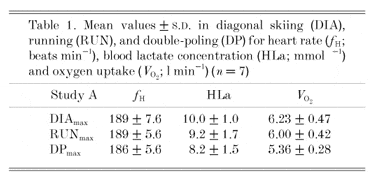Over the years there has been an ongoing discussion about the role of muscle mass for reaching the true maximal oxygen uptake in humans. An early study (Taylor et al. 1955), adding arm exercise to running, resulted in a major elevation in the oxygen uptake, but later studies (Bergh et al. 1976; Millerhagen et al. 1983) have failed to confirm such a major role of engaging both upper and lower body muscles in the exercise. One explanation has been that in most studies, the studied subjects have not had equally trained muscles and that the whole body exercise has not been a ‘natural’ form of movement. In order to overcome these shortcomings we studied elite cross-country skiers when well trained, performing cross-country skiing on roller skis or running on a treadmill. Ethical approval for the study was obtained from the Ethical Committee of Karolinska Institute. In one study (A), using diagonal skiing (DIA) whole body, running (RUN) lower body and double poling (DP) upper body, the measurements were limited to oxygen uptake, heart rate and blood lactate, whereas in the other study (B), using DIA, DP and leg skiing (LEG), cardiac output (Q) was also determined (Fick principle, blood sampling in artery and right atrium).
When the skiers (n = 7) double-poled, they reached ~90 % of their peak oxygen uptake (VO2) compared with exhaustive leg exercise (RUN) (P < 0.05). Diagonal skiing (DIA) further elevated the VO2 ~4 % to 6.23 l min-1 (P < 0.05), i.e. to the same extent as has been observed in most studies in the field. Peak heart rate and blood lactate concentration were similar in the three trials (Table 1).
The results from study B (n = 2-7) revealed that at 75 % VO2,max (~4.0 l min-1), Q, fH, stroke volume (SV), and a-v O2 difference in DIA were similar to that observed in DP and roller skiing with only the legs (LEG). During exhaustive exercise (DIA), the elevation in VO2 to 5.6 l min-1 was brought about by an elevation in fH (176 to 192 beats min-1), SV (~145 to 169 ml), Q (~25.5 to 32.6 l min-1), and a-v O2 difference (~155 to 171 ml l-1). There was only a small difference in arterial saturation between leg and combined arm and leg exercise.
We interpret these data to indicate that upper body muscle mass even in a well-trained athlete is not sufficient to elicit maximal oxygen uptake. Combining arm and leg exercise does increase peak oxygen uptake, but the difference is small and markedly less than could be anticipated from the VO2 reached when performing either lower or upper body exercise, suggesting a central limitation, i.e. systemic oxygen delivery sets an upper limit. Arterial desaturation is only to a minor extent a contributing factor; rather the capacity of the heart to provide a cardiac output sets the upper functional limit.
This work was supported by grants from the Danish Sport Research Council and Team Denmark.

